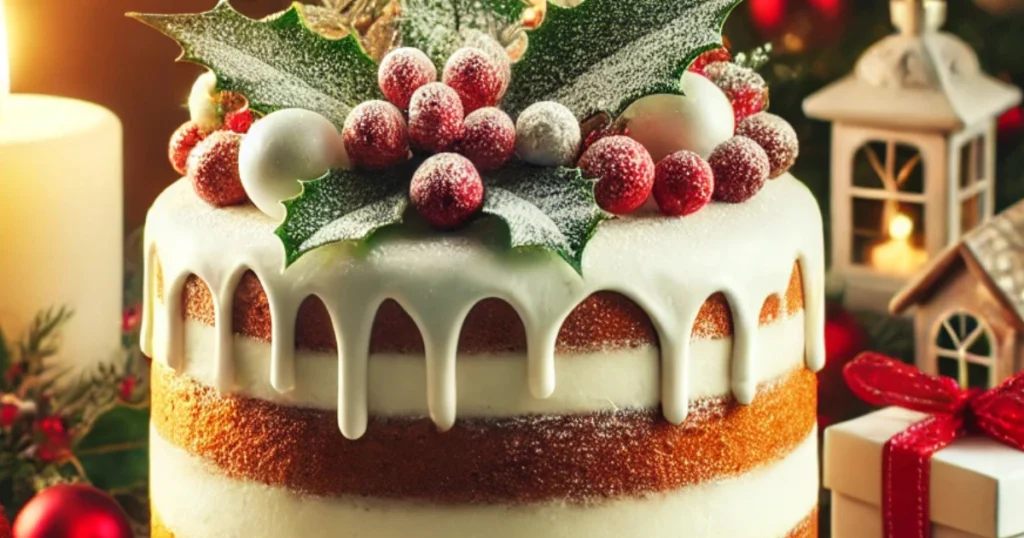Christmas Cake: A Timeless Tradition for the Holidays
Christmas is all about warmth, joy, and, of course, delicious food. Among the many festive treats, the Christmas cake holds a special place in our hearts. This rich, flavorful dessert is often the star of the holiday table, enjoyed by families all over the world. But what is it about Christmas-cake that makes it so beloved?
Table of Contents
History of Christmas Cake
The tradition of baking a special cake for Christmas dates back to the 16th century in England. It was originally a type of plum porridge, enjoyed during the holiday season as a way to use up the leftover meats and grains after the harvest. Over time, this dish evolved into a cake, incorporating dried fruits, nuts, and spices that are synonymous with the Christmas season.
In the 19th century, Christmas-cake became more elaborate, often featuring marzipan and icing, which became the hallmark of modern Christmas cakes. The cake’s association with the holiday grew, with families making it well in advance to allow it to mature, developing deeper flavors over time.
Key Ingredients in a Traditional Christmas Cake
A traditional Christmas-cake is known for its rich, complex flavor profile. The cake’s texture comes from a combination of dried fruits, such as currants, raisins, and sultanas, along with a blend of warming spices like cinnamon, nutmeg, and cloves. The fruits are often soaked in alcohol (usually brandy or rum) to enhance the flavor and keep the cake moist.
Another key ingredient is dark brown sugar, which adds a deep, molasses-like richness. Butter and eggs bring the cake together, giving it a dense yet moist consistency. The inclusion of ground almonds and flour helps balance out the sweetness, providing a firm, yet tender crumb.
Preparing for the Perfect Christmas Cake
Before you start mixing your Christmas cake, it’s important to gather all the necessary tools. You’ll need a deep, round cake pan (ideally 9-10 inches in diameter), parchment paper, and a skewer or toothpick for checking doneness. Be sure to have enough space in your kitchen to mix all the ingredients and for the cake to bake slowly at a low temperature.
The fruits used in Christmas-cake play a vital role in the flavor and texture. Soaking the dried fruits ahead of time in brandy or rum allows the alcohol to infuse into the fruits, giving them a plump, juicy texture. You can soak your fruits for anywhere from a few hours to a couple of days before baking, depending on your preference.
Step-by-Step Recipe for a Classic Christmas Cake
- Preheat your oven to 275°F (135°C) and line your cake pan with parchment paper.
- Soak your dried fruits in brandy or rum for 24-48 hours before baking. Drain the fruits before using.
- Mix the dry ingredients: Combine the flour, baking powder, spices, and ground almonds in a bowl.
- Beat the butter and sugar: until light and fluffy.Add the eggs one at a time, mixing thoroughly after each addition to ensure a smooth and well-combined batter.
- Incorporate fruit-infused orange and lemon peel to add a burst of brightness and elevate the flavor.
- Add the dry ingredients to the butter mixture, and mix until completely combined.
- Transfer the dough to the prepared cake pan and smooth the surface
- Bake slowly for 2-3 hours, checking with a skewer until it comes out clean.
- Cool completely before decorating.
How to Soak Fruits for the Christmas Cake
Soaking the fruits for your Christmas-cake is a crucial step in achieving that rich, moist texture. The best fruits to use are raisins, currants, sultanas, and candied peel, but feel free to experiment with dried apricots, cherries, or figs.
To soak your fruits, simply place them in a bowl and cover them with your chosen alcohol. Stir every few hours and let the fruits soak for at least 24 hours. For a non-alcoholic version, you can use fruit juice such as apple or orange juice.
Decorating Your Christmas Cake
Once your cake is baked and cooled, it’s time to decorate. Traditionally, Christmas cakes are covered in a layer of marzipan, followed by a coat of royal icing. You can then decorate with festive touches like holly, candy canes, or small figurines.
For a modern twist, consider using edible gold dust, fresh fruit, or even chocolate shavings for a contemporary look.

How to Store a Christmas Cake
Christmas-cakes can be stored for several weeks, often improving in flavor as they age. To store your cake, wrap it tightly in parchment paper, followed by foil, and place it in an airtight container. If you want to age your cake further, you can occasionally brush it with alcohol (brandy or rum) to keep it moist.
Troubleshooting Common Christmas Cake Problems
While making a Christmas-cake is fairly straightforward, sometimes things can go wrong. If your cake sinks in the middle, it may have been underbaked or the oven temperature was too high. A cake that’s too dry could be a result of overbaking or insufficient soaking of the fruits.
If your cake burns on top but is undercooked in the middle, try covering the top with foil and continuing to bake it at a lower temperature.
Vegan and Gluten-Free Alternatives for Christmas Cake
If you’re looking for a vegan version of Christmas-cake, you can substitute the butter with a plant-based alternative, and the eggs with flaxseed meal or a commercial egg replacer. For a gluten-free version, use a blend of gluten-free flours like rice flour, almond flour, or potato starch.
Serving Suggestions for Christmas Cake
Christmas-cake is traditionally enjoyed with a hot cup of tea or coffee. You can also pair it with mulled wine, a spiced cider, or even a glass of dessert wine like Port.
For added indulgence, serve the cake with whipped cream, custard, or a dollop of brandy butter.
Making Christmas Cake Ahead of Time
The best part of Christmas-cake is that it’s a make-ahead dessert. In fact, it’s often recommended to bake your cake at least a month before Christmas to allow the flavors to fully develop. If you’re short on time, you can freeze your cake for up to six months and defrost it in the days leading up to Christmas.
The Tradition of Giving Christmas Cake as Gifts
A beautifully decorated Christmas-cake makes a thoughtful and personal gift. To present your cake as a gift, wrap it in decorative parchment paper, tie it with a festive ribbon, and include a small card. This makes for a lovely gesture for family, friends, or neighbors during the holiday season.
Modern Twists on the Classic Christmas Cake
If you want to get creative, you can experiment with new flavors and ingredients. Try adding dark chocolate, candied ginger, or even espresso to give your cake a unique twist. For a lighter version, consider making a fruitcake with fresh fruits or even a cheesecake-style Christmas dessert.
Conclusion: Celebrating Christmas with a Slice of Tradition
The Christmas-cake is more than just a dessert—it’s a symbol of tradition, family, and celebration. Whether you follow the classic recipe or add your own spin, making a Christmas-cake is a great way to bring loved ones together and create lasting memories. With its rich flavors and festive decorations, it’s a cake that truly embodies the spirit of the season.
